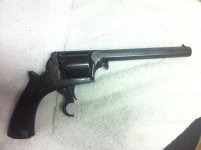I'm on the hunt for some information on an ancient revolver, and I'd just like to share what I have. My half-brother's grandfather gave it to him, and he passed it along to me.
I've done some research on these guns. They were produced from 1851 into the 1870s it appears.
The part that's interesting is the engraving.
Top Strap: Deane Adams and Deane 30 King Williams St London Bridge (typical marking).
Along One Side of the Barrel in a tiny script font:
"The Gift of an Affectionate Friend, To Gordon Hughes ESQ of HM 85th REG on his birthday and departure to India 22nd July 18_4"
Problem is I CAN'T READ THE THIRD NUMBER OF THE DATE. (I'm not positive about the 4 in the date either, but it's my best guess, and 85th could be off, too.
The Indian Rebellion was in 1857. That with the patent date means it could be 54, 64, even 74.
I even searched the web for British military records and found nothing.
I would love to learn more about this gun and the man who owned it. Knowing who the "affectionate friend" is would be interesting, too.
I took a quick picture with my phone. I'm going to try to get some better pics of the thing (I'm a photographer, so it shouldn't be too hard!) The thing has a lot of rust on it, which makes the engraving really hard to read.
That brings me to my next question. Is there anyway to clean it up without damaging the engraving?
By the way, the nipples are beat to hell, but the action functions. The hammer goes back and drops, the cylinder rotates and can be taken out. The trigger is really interesting to use. You can pull back with your ring finger all the way, then use your trigger finger to hit the smaller trigger "lever?". The hammer won't drop unless this is done. You know, just like a Glock.
It appears the ramming lever is gone, and for that matter, the trigger guard, too.
I have it soaked in Hoppes lube to try to halt the rusting.
Basically, I'd like to be able to display this. Any tips on the rust removal (which won't be done if it is too damaging to the engraving) and long term preservation would be greatly appreciated!
I've done some research on these guns. They were produced from 1851 into the 1870s it appears.
The part that's interesting is the engraving.
Top Strap: Deane Adams and Deane 30 King Williams St London Bridge (typical marking).
Along One Side of the Barrel in a tiny script font:
"The Gift of an Affectionate Friend, To Gordon Hughes ESQ of HM 85th REG on his birthday and departure to India 22nd July 18_4"
Problem is I CAN'T READ THE THIRD NUMBER OF THE DATE. (I'm not positive about the 4 in the date either, but it's my best guess, and 85th could be off, too.
The Indian Rebellion was in 1857. That with the patent date means it could be 54, 64, even 74.
I even searched the web for British military records and found nothing.
I would love to learn more about this gun and the man who owned it. Knowing who the "affectionate friend" is would be interesting, too.
I took a quick picture with my phone. I'm going to try to get some better pics of the thing (I'm a photographer, so it shouldn't be too hard!) The thing has a lot of rust on it, which makes the engraving really hard to read.
That brings me to my next question. Is there anyway to clean it up without damaging the engraving?
By the way, the nipples are beat to hell, but the action functions. The hammer goes back and drops, the cylinder rotates and can be taken out. The trigger is really interesting to use. You can pull back with your ring finger all the way, then use your trigger finger to hit the smaller trigger "lever?". The hammer won't drop unless this is done. You know, just like a Glock.
It appears the ramming lever is gone, and for that matter, the trigger guard, too.
I have it soaked in Hoppes lube to try to halt the rusting.
Basically, I'd like to be able to display this. Any tips on the rust removal (which won't be done if it is too damaging to the engraving) and long term preservation would be greatly appreciated!


